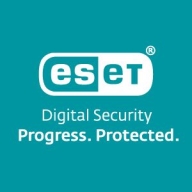

Microsoft Defender for Endpoint and ESET PROTECT Enterprise both compete in the cybersecurity market offering endpoint protection solutions. Microsoft Defender tends to have the upper hand due to its seamless integration with Microsoft products and large user base.
Features:Microsoft Defender for Endpoint includes antivirus, anti-spam, URL syntax checking, firewall, anti-spyware, and unique features like Secret Surf. It is integrated with Microsoft products for enhanced protection and threat intelligence. ESET PROTECT Enterprise offers dynamic groups for endpoint management and zero-day protection, supporting older systems with lightweight operations.
Room for Improvement:Microsoft Defender for Endpoint could improve in ransomware defense, integration with non-Microsoft security products, and user experience simplification. ESET PROTECT Enterprise needs enhancements in customer service, connectivity, and dashboard organization, especially in cloud environments and when managing multiple users.
Ease of Deployment and Customer Service:Microsoft Defender for Endpoint is deployed across on-premises, public, and hybrid cloud environments with varied customer feedback on technical support, ranging from excellent to needing improvement. ESET PROTECT Enterprise is primarily deployed on-premises and in public clouds, often requiring little technical support, indicating smooth operation but lacking detailed feedback on customer support.
Pricing and ROI:Microsoft Defender for Endpoint is often seen as higher-priced compared to standalone products but considered cost-effective when bundled with other Microsoft solutions, with mixed views on ROI due to integration with existing infrastructure. ESET PROTECT Enterprise is generally viewed as affordable, with fair pricing and positive ROI acknowledgment, especially for maintaining security with minimal resource demands.
The return on investment is excellent due to its functionality and ease of installation.
There was money saving from using ESET PROTECT Enterprise, which is why I switched from CrowdStrike to ESET.
Without detection and protection measures, organizations would face substantial payments and reputational damage, including the necessity to inform customers about data breaches, potentially leading to loss of business.
We have seen a return on investment when using Microsoft Defender for Endpoint, as it saves labor by reducing the need for staff to focus on it.
The biggest return on investment for me when using Microsoft Defender for Endpoint is the time saving.
The tech support from ESET is amazing, and I would rate it as ten out of ten.
They are very responsive and help in solving issues quickly.
Even if support is addressing my problem, if the two issues I mentioned are not resolved, then the support process is not complete.
The level-one support seems disconnected from subject matter experts.
I rate Microsoft support 10 out of 10.
Due to our size, we don't have access to direct technical support, but the knowledge base, Microsoft Learn, and the articles available are really good.
It can efficiently scale up to thousands of devices in an organization without issues.
I have used many products before, and this solution is definitely scalable.
It is better suited for workstations rather than server environments.
We managed to scale it out in a short amount of time, with two months of planning and three months of implementation on 10,000 computers.
Microsoft Defender for Endpoint is scalable enough to handle various devices across environments, whether they are laptops, Android devices, or operating in hybrid environments.
Compatibility is its main feature.
When it performs an update, ESET PROTECT Enterprise should request permission for restarting because otherwise, users lose their work.
The solution is stable, and I have not encountered any glitches.
The solution is very, very stable.
I haven't seen any outages with Microsoft.
I rate Defender 10 out of 10 for stability.
Defender for Endpoint is extremely stable.
Sometimes, agents lose connection with the management console, and the administration team needs to reinstall the agents on the computers.
They need to reduce the number of notifications on the endpoints.
It takes a lot of processing power when the machine is initially booted.
Repeated interactions are necessary due to Level One's lack of tools and knowledge, hindering efficient problem-solving and negatively impacting our experience with Microsoft support.
In contrast, competing products offer reduced pricing for long-term commitments, which makes it difficult for us in that environment.
We use Microsoft partners to help govern the platform, and as part of an alliance, we want to gather data from each tenant and combine them for a complete view.
I pay 40 dollars per agent annually, which is cheaper than 60 dollars per agent for Check Point.
We recently paid fourteen dollars and thirty-six cents per unit for 20 users, which is reasonable.
Comparing it to other solutions in the market, it was slightly higher.
Given our extensive Microsoft licensing, transitioning to Defender for Endpoint did not affect licensing costs.
It costs $15 per VM for the P2 plan, which is seen as affordable for customers.
The pricing, setup, and licensing were very easy and simple.
It allows simple whitelisting and has a learning mode for new installations, which reduces false positives by adapting to typical user habits.
Its web component prevents infections from malicious websites, which enhances its anti-malware capabilities.
One of the strong features of ESET PROTECT Enterprise is its ability to work well on old computers.
Defender for Endpoint's coverage across different platforms in our environment is pretty good. We have devices running Linux, Mac OS, Windows, iOS, and Android. It covers all of them.
Microsoft Defender for Endpoint provides a unified management interface allowing customers to manage their on-premises and hybrid infrastructures from a single pane.
One of the best features of Microsoft Defender for Endpoint is its database for identifying zero-day attacks or malware attacks.
| Product | Market Share (%) |
|---|---|
| Microsoft Defender for Endpoint | 13.7% |
| ESET PROTECT Enterprise | 2.2% |
| Other | 84.1% |


| Company Size | Count |
|---|---|
| Small Business | 11 |
| Midsize Enterprise | 2 |
| Large Enterprise | 2 |
| Company Size | Count |
|---|---|
| Small Business | 79 |
| Midsize Enterprise | 34 |
| Large Enterprise | 87 |
ESET PROTECT Enterprise ensures real-time visibility for all endpoints as well as full reporting and security management for all OSes
Microsoft Defender for Endpoint is a comprehensive security solution that provides advanced threat protection for organizations. It offers real-time protection against various types of cyber threats, including malware, viruses, ransomware, and phishing attacks.
With its powerful machine-learning capabilities, it can detect and block sophisticated attacks before they can cause any harm. The solution also includes endpoint detection and response (EDR) capabilities, allowing organizations to quickly investigate and respond to security incidents. It provides detailed insights into the attack timeline, enabling security teams to understand the scope and impact of an incident.
Microsoft Defender for Endpoint also offers proactive threat hunting, allowing organizations to proactively search for and identify potential threats within their network. It integrates seamlessly with other Microsoft security solutions, such as Microsoft Defender XDR, to provide a unified and holistic security approach. With its centralized management console, organizations can easily deploy, configure, and monitor the security solution across their entire network.
Microsoft Defender for Endpoint is a robust and scalable security solution that helps organizations protect their endpoints and data from evolving cyber threats.
We monitor all Anti-Malware Tools reviews to prevent fraudulent reviews and keep review quality high. We do not post reviews by company employees or direct competitors. We validate each review for authenticity via cross-reference with LinkedIn, and personal follow-up with the reviewer when necessary.